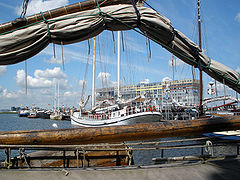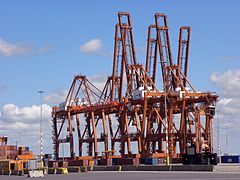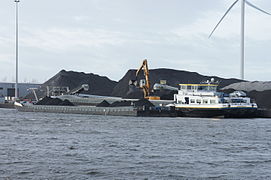Port of Amsterdam
| Port of Amsterdam | |
|---|---|
 Click on the map for a fullscreen view | |
| Location | |
| Country | Netherlands |
| Location | Amsterdam, North Holland |
| Coordinates | 52°24′43″N 4°48′28″E / 52.4120°N 4.8079°E |
| UN/LOCODE | NLAMS[1] |
| Details | |
| Opened | 13th century |
| Operated by | NV Haven Amsterdam[2] |
| Owned by | Amsterdam[2] |
| Size of harbour | 620 ha (1,500 acres)[3] |
| Land area | 1,995 ha (4,930 acres)[3] |
| Employees | 60,000 (2015)[4] |
| President & CEO | Koen Overtoom[5] |
| Statistics | |
| Vessel arrivals | |
| Annual cargo tonnage | |
| Annual container volume | |
| Passenger traffic | |
| Annual revenue | |
| Net income | |
| Website www | |

The port of Amsterdam (Dutch: Haven van Amsterdam) is an inland seaport in Amsterdam in North Holland, Netherlands. It is the 14th busiest port in Europe by total cargo tonnage.[8] In 2023, the port of Amsterdam had a cargo throughput of 63 million tons.[6]
The port is located on the bank of a former bay named the IJ and the North Sea Canal, with which it is connected to the North Sea. The port was first used in the 13th century and was one of the main ports of the Dutch East India Company in the 17th century. Today, the port of Amsterdam is the second largest port in the Netherlands, after the Port of Rotterdam.
History
[edit]
The first port activities in Amsterdam date back to the 13th century. The port was first mentioned in the year 1342, when the city of Amsterdam received city rights.[9]
In the Dutch Golden Age the port was one of the main harbours of the Dutch East India Company.[9]
The North Holland Canal, that connects Amsterdam to Den Helder was dug between 1819 and 1824. The North Sea Canal, that connects Amsterdam to IJmuiden, was dug between 1865 and 1876.[9]
Geography
[edit]


The port of Amsterdam is located on the banks of the North Sea Canal and the IJ. The port is connected to the North Sea through the North Sea Canal, to Den Helder through the North Holland Canal, to the Markermeer through the IJ and the IJmeer, and to the Rhine through the Amsterdam-Rhine Canal.
In total, the port comprises 620 ha (1,500 acres) of waterways and 1,995 ha (4,930 acres) of land area, including port estates, quays, roads, railway tracks, ditches and green space.[3]
The port comprises several harbour areas, which are part of the boroughs (Dutch: stadsdelen) of Westpoort, Westerpark, Centrum, and Zeeburg. From west to east the areas are:[10]
- Afrika Harbour (Dutch: Afrikahaven)
- Amerika Harbour (Dutch: Amerikahaven)
- West Harbour (Dutch: Westhaven)
- Jan van Riebeeck Harbour (Dutch: Jan van Riebeeckhaven)
- Petroleum Harbour (Dutch: Petroleumhaven)
- Coen Harbour (Dutch: Coenhaven)
- Mercurius Harbour (Dutch: Mercuriushaven)
- Hout Harbour (Dutch: Houthaven)
- De Ruijter Quay (Dutch: De Ruijterkade)
- Eastern Trade Quay (Dutch: Oostelijke Handelskade)
- Eastern Harbour Area (Dutch: Oostelijk Havengebied)
Business operations
[edit]In terms of cargo throughput, the port of Amsterdam is the second largest port of the Netherlands after the port of Rotterdam.[11]
In 2008, 6,029 sea vessels visited the port of Amsterdam, with a cargo throughput of 75.8 million tons, most of which was bulk cargo. That same year, the total container volume was 435,129 TEU. Both the number of vessels and the bulk cargo and container throughput increased compared to 2007.[12]
In 2008, the total revenue was € 125.3 million and the net income € 45.0 million. This is a minor decrease compared to the revenue and income in 2007.[12]
In 2008, the port itself had 361 employees, but the number of indirect employees is circa 55,000.[12] On 7 July 2009, Mrs. Dertje Meijer was appointed as the director of the port by the government of Amsterdam.[13]
In 2014, the port of Amsterdam had a cargo throughput of 97.4 million tons, most of which was bulk cargo.[4]
In 2023, the revenue increased to €190.4 million, but transhipment decreased to 63 million tons due to a decline in fossil fuel transhipment.[6] This was a 20% transhipment decline compared to 2022.[6] Transhipment of coal fell by 48% to 7.4 tons.[6] The Port of Amsterdam transitions to more non-fossil activities.[6] Contract revenue in 2023 rose to €115.6 million from €103.6 million in the previous year.[6]
Cruise port
[edit]The Port of Amsterdam is the 3rd biggest cruise port in Europe with 140 sea cruise ships and 1500 river cruise ships. Almost 700,000 cruise passengers per year visit Amsterdam. There are two cruise terminals: the Passenger Terminal Amsterdam in the city center, and one after the locks in IJmuiden. In 2015 Amsterdam won the prize for International Cruise Port of the Year.[citation needed]
Amsterdam is homeport for the Koningsdam, the new ship from Holland America Line. In September 2015, the MSC Splendida visited Amsterdam; at 333.33 meters long and 38 meters wide, it was the biggest cruise ship ever in Amsterdam.[citation needed]
Havenmeester
[edit]The CEOs of the Port of Amsterdam have the title havenmeester (harbor master). Since the Dutch Golden Age (16th century), the Havenmeester of Amsterdam was based in the Schreierstoren at the Prins Hendrikkade 94. In 1960, the head office moved to the new Havengebouw on De Ruijterkade. Since 2016, the havenmeester is Koen Overtoom.[5]
Sustainability
[edit]The Port of Amsterdam aims to be at the top of Europe's sustainable ports by 2030. The Port divides their sustainability vision into five themes: Energy transition in a circular economy, Environment and habitat, Clean and safe shipping, Work and credentials, and responsible trade chains.[14]
International cooperation
[edit]The port of Amsterdam has a connection with the ports of the following cities:[15]
 Port of Accra, Ghana
Port of Accra, Ghana Port of Beijing, China
Port of Beijing, China Port of Cape Town, South Africa
Port of Cape Town, South Africa Port of Halifax, Canada (Until 2019)
Port of Halifax, Canada (Until 2019) Port of San Pédro, Côte d'Ivoire
Port of San Pédro, Côte d'Ivoire Port of Tianjin, China
Port of Tianjin, China Port of Xiamen, China
Port of Xiamen, China Gwangyang Bay Free Economic Zone, South Korea (2018)
Gwangyang Bay Free Economic Zone, South Korea (2018)
Gallery
[edit]-
Neptunushaven
-
Houthaven
-
The Poseidon, tugboat at the port
-
Alaskahaven (containers)
-
Zanzibarhaven
-
Passengers terminal
-
Heliport in the port
References
[edit]- ^ "UNLOCODE (NL) - NETHERLANDS". service.unece.org. Retrieved 25 April 2020.
- ^ a b Frequently Asked Questions Archived 2013-06-30 at archive.today, Port of Amsterdam, 2013. Retrieved on 2013-05-21.
- ^ a b c Factsheet Sites & space Archived 2016-03-04 at the Wayback Machine, Port of Amsterdam, 2013. Retrieved 2013-05-21.
- ^ a b c d e f Annual Report 2011 Archived 2016-03-04 at the Wayback Machine, Port of Amsterdam, 2012. Retrieved on 2013-05-21.
- ^ a b Bart van Zoelen (6 December 2016). "Koen Overtoom gaat de Amsterdamse haven leiden". Het Parool. Archived from the original on 21 January 2021.
- ^ a b c d e f g "Annual report 2023: Amsterdam port in full transition". Port of Amsterdam. 23 April 2024. Archived from the original on 27 July 2024.
- ^ Port of Amsterdam, annual report 2014
- ^ List of busiest ports in Europe
- ^ a b c The port of Amsterdam Archived 2010-03-09 at the Wayback Machine. Port of Amsterdam. Retrieved on 2009-07-17.
- ^ Portmap Archived 2009-02-21 at the Wayback Machine. Port of Amsterdam. Retrieved on 2009-07-17.
- ^ (in Dutch) Jaarverslag 2008 Archived 2011-07-24 at the Wayback Machine. Nationale Havenraad. Retrieved on 2009-07-23.
- ^ a b c Annual report 2008 Archived 2011-07-24 at the Wayback Machine. Port of Amsterdam. Retrieved on 2009-07-17.
- ^ Dertje Meijer, new director Port of Amsterdam[permanent dead link]. Port of Amsterdam. Retrieved on 2009-07-17.
- ^ "Duurzaamheid". PortOfAmsterdam.com. Port of Amsterdam. Retrieved 11 January 2018.
- ^ Bureau Internationale Betrekkingen Archived 2006-12-06 at the Wayback Machine. City of Amsterdam. Retrieved on 2009-07-01.
External links
[edit]- Port of Amsterdam, official website







